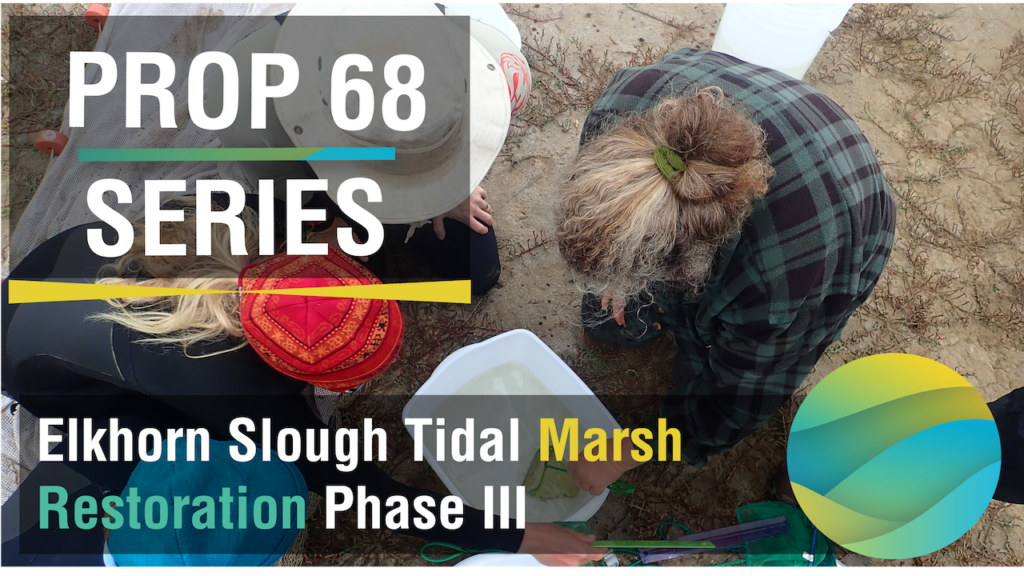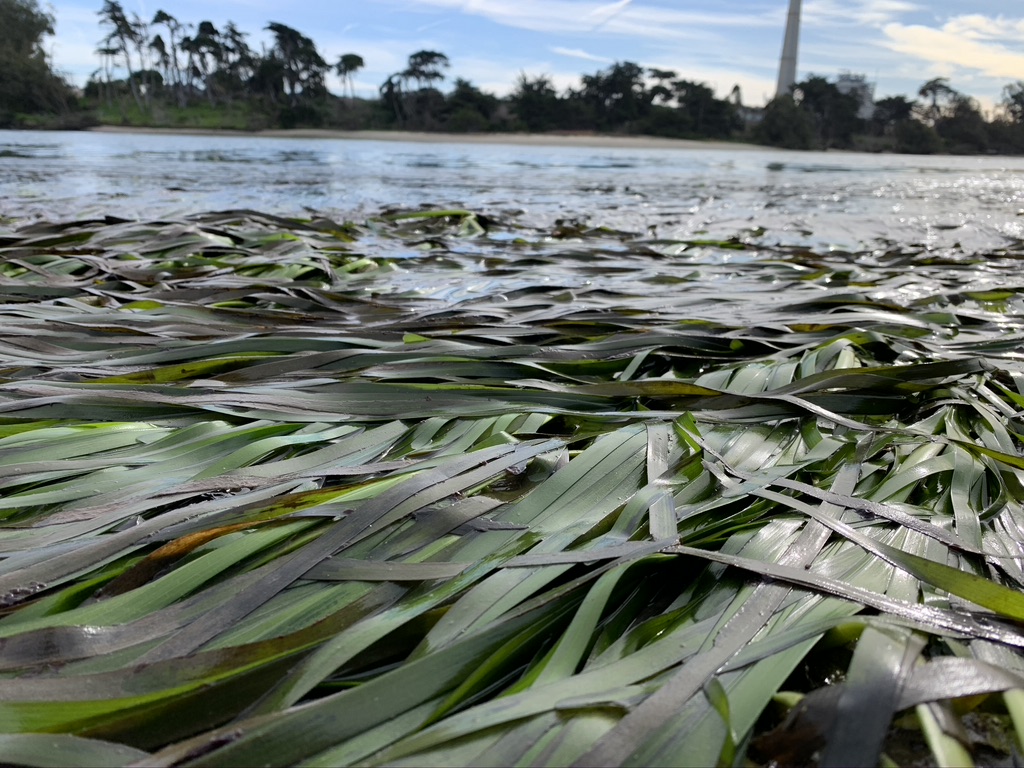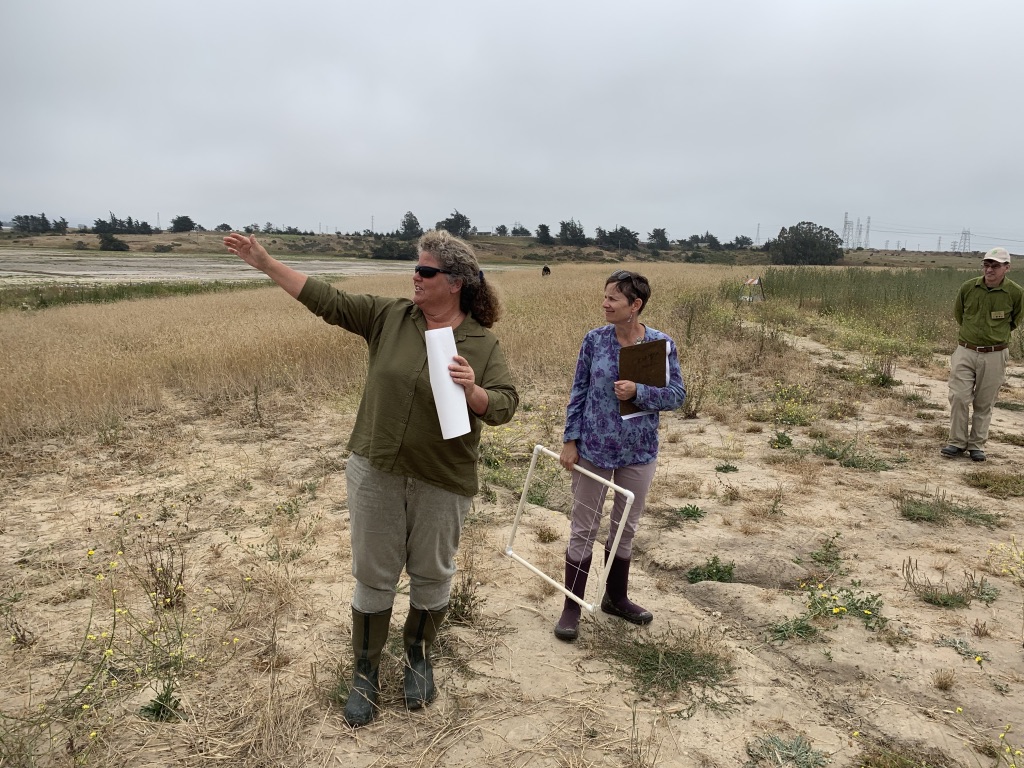Prop 68 Climate Resilience Miniseries Episode 6: Elkhorn Slough Tidal Marsh Restoration Phase III
“Our hope is that this project will demonstrate we can undo past damage and that it’s worth it because you cannot have healthy humans without a healthy environment” – Monique Fountain
Today we are visiting Elkhorn Slough. Designated a “Wetland of International Importance” by the Ramsar Convention, the Slough supports a diversity of species, ranging from harbor seals to Dungeness crab. Of course, the Slough is known for the large resident population of southern sea otters that can be seen by the visiting public at close range swimming in the tidal creeks, foraging in the eelgrass meadows, and resting on the salt marsh where they frequently haul out.  While these charismatic and fuzzy animals are effective at drawing in the public and fostering stewardship across the broader Monterey Bay community, equally as important are our coastal foundation species (salt marsh, eelgrass, oysters) which are responsible for building the emblematic ecosystems of the California coast.
While these charismatic and fuzzy animals are effective at drawing in the public and fostering stewardship across the broader Monterey Bay community, equally as important are our coastal foundation species (salt marsh, eelgrass, oysters) which are responsible for building the emblematic ecosystems of the California coast.
This Prop 68 Project will complete the last 30 acres of a 119-acre tidal marsh restoration project and includes the restoration of tidal marsh, eelgrass beds, and Olympia oysters. Reversing the degradation that Elkhorn Slough has experienced over the past 150 years, this project aims to re-build a coastal landscape that is resilient to sea-level rise. The Project Team includes multiple state agencies, academics, and the Amah Mutsun Tribal Band. “This is our chance to bring back some of those wild places in partnership with Native Americans so that these coastal habitats can once again provide the sort of values that they have in the past as a legacy for future generations” notes Dr. Kerstin Wasson, science lead on the project.
 While the team acknowledges that it will take time for this coastal landscape to look and act like the surrounding natural habitats, they are optimistic and enjoying being witness to this transformation. “It’s not often that you get to study a community rebuilding itself, basically from scratch,” says Rikke Jeppesen, an Estuarine Ecologist on the project.
While the team acknowledges that it will take time for this coastal landscape to look and act like the surrounding natural habitats, they are optimistic and enjoying being witness to this transformation. “It’s not often that you get to study a community rebuilding itself, basically from scratch,” says Rikke Jeppesen, an Estuarine Ecologist on the project.
“It’s exciting to me that we can affect this landscape and create a place that’s not only really productive but incredibly scenic…it’s beautiful out there,” adds Dave Feliz, the Elkhorn Slough National Estuarine Research Reserve Manager.
To restore the salt marsh, approximately 130,000 cubic yards of sediment will be added to the degraded and drowning marsh plain. The eelgrass restoration component of the project is being led by Dr. Kathryn Beheshti and will involve transplanting 800 shoots into the constructed tidal channels. For this part of the restoration, the research team is investigating whether tidal channels with transplanted eelgrass experience slower rates of bank erosion and greater bank stability compared to channels without eelgrass. In an effort to bring the Olympia oyster population in the Slough back from near extinction, at least 50,000 juvenile individuals will be introduced to the system using conservation aquaculture techniques.

Left, Monique Fountain, Tidal Wetland Program Director. Right, Kerstin Wasson, ESNERR Research Coordinator
Typically, wetland restorations focus on restoring a single foundation species, this project is unique in that it will include the restoration of three estuarine foundation species, including one [Olympia oysters] that is functionally extinct in the estuary.
“It’s always important to remember that conserving high quality, existing habitat is your number one choice, restoration is your only option if everything has been lost and you need to bring it back,” comments Dr. Wasson.
To learn more about this project, check out this video!
Resources:
Elkhorn Slough Tidal Wetland Program
Amah Mutsun Tribal Band Land Trust Website
Elkhorn Slough Foundation’s Otter Cam
Serendipity in a Salt Marsh – The Scientific Naturalist Article
Historical Ecology of Elkhorn Slough – Estuaries Article
Video/Photos provided by:
The Elkhorn Slough Foundation (Otter Cam)
Fuller Gerbl
John Haskins
Kathryn Beheshti
About Dave Feliz: Dave is the Reserve Manager of the Elkhorn Slough National Estuarine Research Reserve. Dave has been working for the Department of Fish and Wildlife since 1988.
About Monique Fountain: Monique is the Director of the Tidal Wetland Program at the Elkhorn Slough National Estuarine Research Reserve. She received her Master’s in Marine Science from San Francisco State University with a minor in Computer Science and has been working at the Reserve since 2009.
About Dr. Kerstin Wasson: Kerstin is the Science Lead on this Prop 68 Project. She is the Research Coordinator of the Elkhorn Slough National Estuarine Research Reserve and Adjunct Faculty at the University of California, Santa Cruz. Kerstin earned her Ph.D. in Biology from the University of California, Santa Cruz.
About Dr. Rikke Jeppesen: Rikke is an Estuarine Ecologist with the Elkhorn Slough National Estuarine Research Reserve. She earned her Ph.D. in Ecology & Evolutionary Biology from the University of Santa Cruz and has been with the NERR since 2006 where she started as a Graduate Research Fellow.
About the Author: Dr. Kathryn Beheshti is a 2021 California Sea Grant State Fellow with the Ocean Protection Council’s Climate Change Program. Kat’s own research focuses on understanding the drivers of loss and recovery of key coastal foundation species (e.g. salt marsh plants and seagrasses). Kat is committed to making science accessible to individuals of all ages and demographics. She hosts her own science communication platform, sloughit.com and participates in an interdisciplinary science communication team at SciAll.org, where she is a Lead Vlogger. Before becoming a CA Sea Grant State Fellow with OPC, Kat was listed as the Project Lead for the eelgrass component of this Prop 68 Project. She has been involved in Phases I and II of the Hester Marsh Restoration and will continue her work at Hester when her fellowship ends in early 2022.

